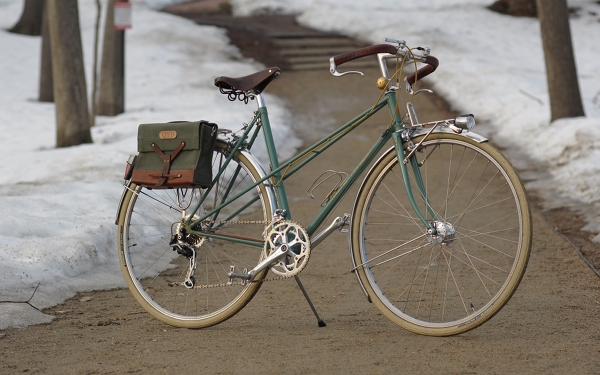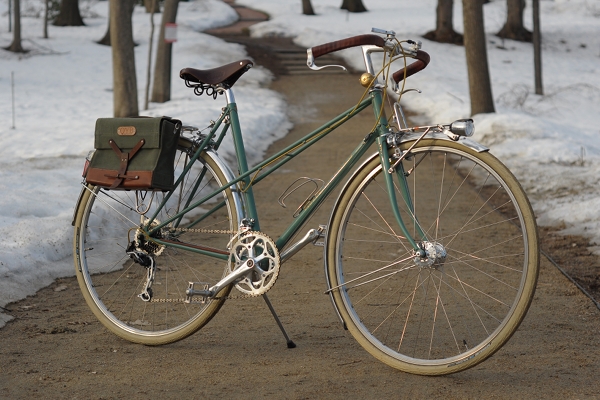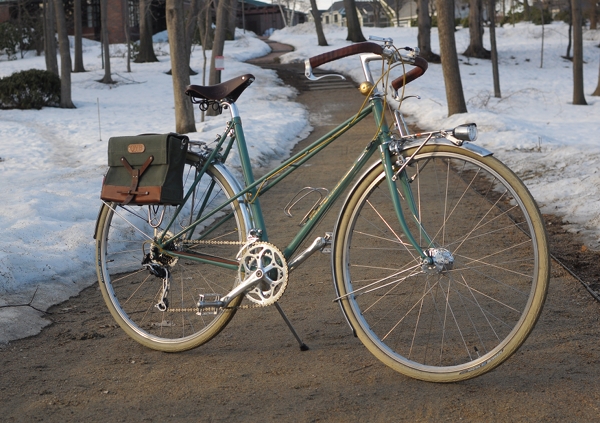I had three lenses with me in the camera bag yesterday, so I thought it would be neat to illustrate how different lenses affect the way a bicycle looks in pictures. Here are three photos of my mixte standing in the same position, taken with (left to right:) an 85mm lens, a 50mm lens, and a 35mm lens, using identical camera settings. Notice any differences?
Here is a closer look at the picture taken with the 85mm lens. First off, notice the relationship of the bicycle to the trees: In this picture the bike looks like it is positioned in between the trees. There are hardly any trees in the frame itself and if I wanted to I could crop them out all together, making the bike an isolated object in the midst of snow and sand. There is also not a great deal of background information in the space above the bike: a few stairs, but that is all. Furthermore, the things in the background are kind of blurry in comparison to how sharp the bicycle itself looks. And finally, take a look at the size of the bicycle's wheels. The bike is slightly turned toward the camera and the front wheel is closer to me than the rear. But despite this, the front wheel does not look much larger than the rear; the bicycle looks proportional. The 85mm lens is considered a "portrait lens" precisely because it creates these effects: It isolates the subject from the clutter of surrounding objects and reduces unflattering foreshortening effects in the subject's face and body.
Now the same scene, but taken with a 50mm lens. Notice how much more background information is visible in this picture. And it's impossible to crop out, because all that extra stuff is directly behind the bike, rather than around it. The same trees that were spread out to the right and left in the previous picture, now overlap with the bike's wheels and can't be cropped out. More stuff in the space above the bike is visible as well - now we see not just the stairs, but a winding path. And the background scenery is in sharper focus than in the previous picture. It's a nice composition as far as narrative goes (we get more of a sense of the bicycle being in the woods), but a portrait or product photographer would tell you that the background is starting to compete with the subject of the photo. One of the trees looks like it's growing out of the pannier, and the winding path draws the eye away from the forms of the bike itself.
And same scene once again, but with a 35mm lens. The entire patch of woods and the street behind it have now been wrangled into the shot. The background scenery is just as sharp as the bicycle itself, and there's so much of it, that the scene looks altogether cluttered. Also, notice that the front wheel of the bicycle looks considerably larger than the rear, as a result of being closer to the camera. Foreshortening effects are pretty strong with this lens: If I were photographing a person's face, their nose would appear exaggeratedly large in comparison to their eyes for the same reason as the mixte's wheels look to be different sizes.
There is much more to be said about differences between these lenses, and in fact I haven't given a proper introduction to camera lenses at all - but that would take ages and it's nothing you can't find in an online reference. Hopefully, these pictures illustrate the way in which lenses play a role in bicycle photography, and why sometimes it seems like you just can't compose the shot you want with your camera. For those of you who use digital SLRs with interchangeable lenses, which do you prefer to use for bicycle photos?










0 comments:
Post a Comment